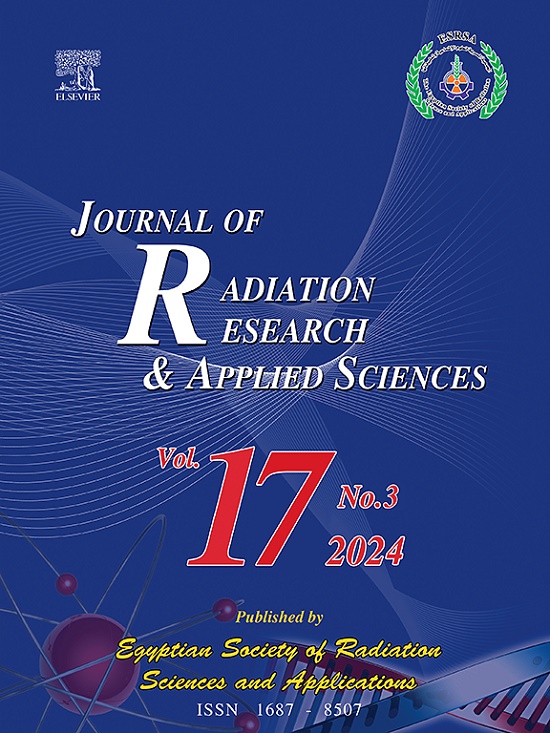MNR2NeXt-50: Segmentation and quantification of epicardial fat from cardiac CT images using transfer learning with an optimized ensemble model
IF 1.7
4区 综合性期刊
Q2 MULTIDISCIPLINARY SCIENCES
Journal of Radiation Research and Applied Sciences
Pub Date : 2025-05-28
DOI:10.1016/j.jrras.2025.101648
引用次数: 0
Abstract
Excessive epicardial adipose tissue (EAT) presents a significant risk for cardiac issues. The level of EAT can be assessed using CT images of the heart. Machine learning and deep learning techniques are available to quantify EAT through the segmentation and analysis of CT images automatically. These techniques require precise segmentation and faster processing. This study proposes a hybrid method that combines the ResNeXt-50 deep learning model with Naïve Bayes-based ensemble learning and Manta Ray Foraging Optimization (MRFO) to enhance the segmentation process. Various Naïve Bayes ensemble configurations, such as Random Forest, AdaBoost, XGBoost, Extra Trees, CatBoost, and Generalized Linear Model were analysed to identify the optimal configuration. The techniques were evaluated on images with resolutions of 128 × 128, 256 × 256, and 512 × 512 pixels using metrics including accuracy, precision, recall, Dice score, and processing time. These models were trained and validated with a dataset having 878 CT slices from 20 patient scans, utilizing an 80-20 train-test split and five-fold cross-validation for robustness. Among the tested configurations, the Naïve Bayes with Random Forest ensemble (MNR2NeXt-50) demonstrated better performance, yielding an accuracy of 98.88 %, a Dice score of 98.79 %, and a processing time of 1.25 s per image for 512 × 512 pixels at 5-fold cross-validation. Further, compared to other existing methods, the MNR2NeXt-50 shows improvements in accuracy (0.12 %–12.88 %), Dice score (0.06 %–31.59 %), and processing time (1.152–1504 times faster). Future efforts will focus on clinical validation, expanding the dataset through multi-center collaborations, exploring integration with multi-modal imaging, and investigating the association between EAT and other clinical indicators to facilitate broader clinical adoption.
MNR2NeXt-50:使用迁移学习和优化的集成模型从心脏CT图像中分割和量化心外膜脂肪
过多的心外膜脂肪组织(EAT)是心脏问题的重要风险。可以通过心脏的CT图像来评估EAT的水平。机器学习和深度学习技术可以通过对CT图像的自动分割和分析来量化EAT。这些技术需要精确的分割和更快的处理。本研究提出了一种将ResNeXt-50深度学习模型与Naïve基于贝叶斯的集成学习和蝠鲼觅食优化(MRFO)相结合的混合方法来增强分割过程。分析了Random Forest、AdaBoost、XGBoost、Extra Trees、CatBoost和Generalized Linear Model等不同的Naïve Bayes集成配置,以确定最优配置。在分辨率为128 × 128、256 × 256和512 × 512像素的图像上评估这些技术,使用的指标包括准确性、精密度、召回率、Dice评分和处理时间。这些模型使用来自20名患者扫描的878个CT切片的数据集进行训练和验证,利用80-20训练测试分割和五倍交叉验证鲁棒性。在测试的配置中,Naïve与随机森林集成的贝叶斯(MNR2NeXt-50)表现出更好的性能,准确率为98.88%,Dice得分为98.79%,在5倍交叉验证下,512 × 512像素的处理时间为1.25 s。此外,与其他现有方法相比,MNR2NeXt-50在准确率(0.12% - 12.88%),Dice分数(0.06% - 31.59%)和处理时间(1.152-1504倍)方面都有提高。未来的工作将集中在临床验证,通过多中心合作扩展数据集,探索与多模态成像的整合,以及研究EAT与其他临床指标之间的关联,以促进更广泛的临床应用。
本文章由计算机程序翻译,如有差异,请以英文原文为准。
求助全文
约1分钟内获得全文
求助全文
来源期刊

Journal of Radiation Research and Applied Sciences
MULTIDISCIPLINARY SCIENCES-
自引率
5.90%
发文量
130
审稿时长
16 weeks
期刊介绍:
Journal of Radiation Research and Applied Sciences provides a high quality medium for the publication of substantial, original and scientific and technological papers on the development and applications of nuclear, radiation and isotopes in biology, medicine, drugs, biochemistry, microbiology, agriculture, entomology, food technology, chemistry, physics, solid states, engineering, environmental and applied sciences.
 求助内容:
求助内容: 应助结果提醒方式:
应助结果提醒方式:


